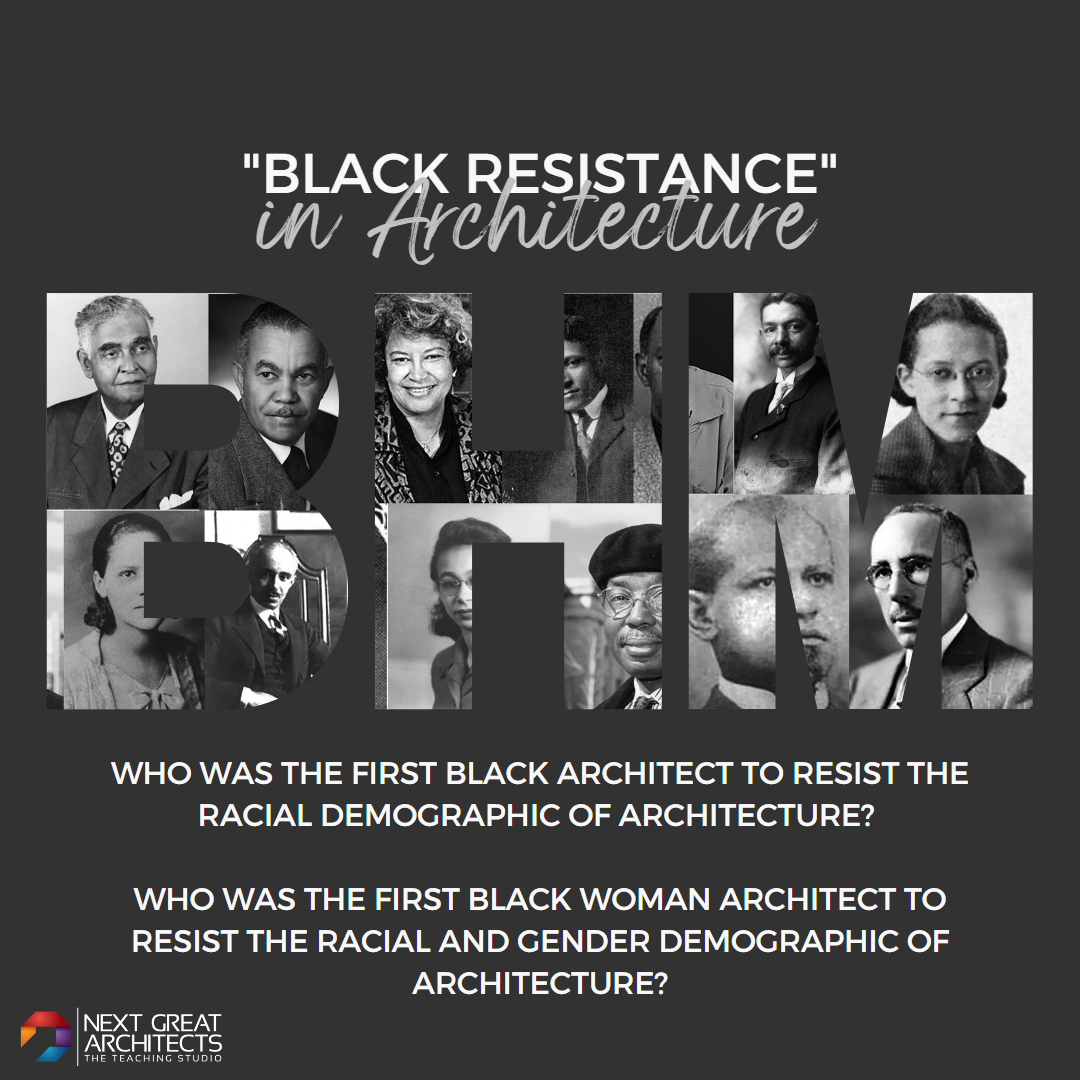Black History in Architecture
February is Black History Month. Next Great Architects is a teaching studio that uses history to educate and inspire. In the pursuit of architecture, students at every college and university study architecture history to gain an understanding of the types and styles of architecture as well as the people who contributed to the evolution of design. This month we will focus on Black History in Architecture, and we hope that our readers are inspired and learn about someone new.
Why is there Black History Month?
The celebration originated as Black History Week during the second week of February in 1926. Carter G. Woodson established the celebration as a way to teach people about the contributions of African Americans because it was not something that was taught in schools leaving many unaware. The study of history was and still is very important because it brings an understanding of identity and builds pride despite the unfortunate circumstances Black Americans face. The week was selected because it encompassed the birthdays of Frederick Douglas and Abraham Lincoln, who were individuals that represented freedom for the Black Community. Black History Week was very successful and college students began to demand to have complete courses about Black History. In 1976, Black History Week was officially expanded to Black History Month and recognized by President Ford.
What is the Black History Month Theme?
Each Black History Celebration since 1928 has held a theme to center the focus of education. This year, the 2023 theme for Black History Month is “Black Resistance.” Resistance is defined as the ability not to be adversely affected by something. Next Great Architects is celebrating Black History Month by focusing on the Black Resistance in Architecture.
Black Resistance in Architecture
Architecture has been known as “the gentleman’s profession,” but initially that did not include black men. Who was the first black architect to resist the racial demographic of architecture? Who was the first black woman architect to resist the racial and gender demographic of architecture?
Robert Robinson Taylor
Robert Robinson Taylor resisted the laws of Jim Crow and was allowed to enroll in the architecture program of The Massachusetts Institute of Technology. Because of his resistance, he became the first black architect to be an accredited/licensed architect.
Robert Robison Taylor was born in 1868. He was the first African American to enroll at MIT and became the first accredited African American architect when he graduated in 1892. After graduating, he joined Booker T. Washington of the Tuskegee Institute, now Tuskegee University designed many of the early buildings and developed the industrial design curriculum based on his MIT education. He designed buildings at other Historically Black Colleges and Universities (HBCUs), but the building he was most proud of was the Tuskegee Chapel. He died in his favorite building in 1942 during a chapel service. He is featured on a US postage stamp, and the Taylor School of Architecture and Construction Science at Tuskegee University is named after him.
Beverly Loraine Greene
Beverly Loraine Greene resisted the male domination of architecture and became the first black woman-accredited/licensed architect. She earned her degree from the University of Illinois Urbana-Champaign.
Beverly Loraine Greene was born in 1915. She was the first African American woman to earn an architectural engineering degree from the University of Illinois Urbana-Champaign. She was very involved at the university and was the only woman and only African American member of the American Society of Civil Engineers. She was also a member of Delta Sigma Theta Sorority, Inc., and Cenacle, a drama club. She went on to earn a master’s degree in city planning and housing. In 1942, she became the first licensed African American woman architect in the United States. Her work on the Ida B. Wells' Housing project for the Chicago Housing Authority would give her the experience she needed to be hired to design the Metropolitan Life Insurance Company's development project at Stuyvesant Town. Three days after she was hired, she discovered that black residents would not be allowed to live in the development. She resisted being used to disguise and deflect accusations of racism and resigned from the project. Instead, she accepted a scholarship to attend Columbia University for a Master of Architecture. She designed several buildings throughout her career. Her last projects were the United Nations Headquarters in Paris and buildings for New York University’s University Heights Campus.
Paul Revere Williams, FAIA
Paul Revere Williams resisted the effects of Jim Crow by mastering how to draw upside down because his white clients did not feel comfortable sitting next to a black man. He was the first African American member of the American Institute of Architects..
Paul Revere Williams was born in 1894. He received an architectural engineering degree from the University of Southern California and designed several homes while still a student. He became a certified architect in California in 1921 and was the first certified African American architect west of the Mississippi. He started his architectural practice and had to perfect the skill of drawing upside down. His white clients didn’t feel comfortable sitting side by side with a black man, so he learned how to draw sitting across the table while the drawing remained right side up for his client. He designed over 2,000 buildings and celebrity homes and became known as the architect to the stars. In 1957, he was the first Black member to be inducted into the AIA's College of Fellows. Paul Williams, FAIA achieved many honors. He won the AIA Award of Merit in 1938, the Omega Psi Phi Fraternity, Man of the Year award in 1951, the Spingarn Medal from the NAACP, and honorary doctorates from Lincoln University of Missouri, Howard University, and the Tuskegee Institute. In 2017, Paul R. Williams, FAIA posthumously received the AIA Gold Medal, the highest honor of the American Institute of Architects.
Norma Merrick Skalerk, FAIA
Norma Merrick Skalerk resisted the lack of representation of Black women in architecture and became the first African-American woman to be a member of the American Institute of Architects.
Norma Merrick Sklarek was born in 1926. She received her Bachelor’s in Architecture at Columbia University as the only African American woman in her graduating class with an architecture degree. She was the first African American woman licensed in New York and California. She taught architecture classes at the New York City Community College while working full-time as an architect. She broke many barriers in her career such as becoming the first female vice president and first African American female director at Gruen and Associates, the first African American woman to become a member of the American Institute of Architects, and eventually the first black woman to be elected into the AIA College of Fellows.
She co-founded Siegel, Sklarek, and Diamond, then the largest woman-owned firm, making her the first black woman to own an architectural practice. She served the community of architecture in many ways, especially by mentoring many young women pursuing architecture. She was inducted as an Honorary Member of Delta Sigma Theta Sorority, Inc. in 1998.
Other Black Architects to Research
Abele, Julian Francis
Bailey, Walter Thomas
Brent, Calvin Thomas Stowe
Brooks, Elizabeth Carter
Brown, Georgia Louise Harris
Butler, Alberta Jeannette Cassell
Carlisle, Alma Fairfax Murray
Furman, Ethel Madison Bailey
McKissack, Calvin Lunsford
McKissack, Moses III
Meredith, Amaza Lee
Parker, Helen Eugenia
Rayfield, Wallace Augustus
Robinson, Hilyard Robert
Tandy, Vertner Woodson
Thompson, Martha Ann Cassell
Wigington, Clarence Wesley
Williston, David Augustus
Black Representation in Architecture Today
To be the first to do something takes tremendous courage, focus, and passion. It also makes the journey for those who come after you a little bit easier. Knowing the history of blacks in architecture can help future black architects push through and resist obstacles because they are aware of the possibilities. Today, Black Architects account for only 2% of architects in the United States, and black women account for 0.4%. For the numbers to represent the demographic of the country, there is still progress to be made and circumstances to be resisted. The celebration of black resistance in architecture is the first step to witnessing the increase of those numbers in the future.
Next Great Architects is an award-winning teaching studio that introduces architecture to students as early as kindergarten and nurtures them through college and licensure. Contact us if you are interested in bringing our programs to your children, schools, or organizations.
Do you need help asking someone to be your mentor?
Click HERE to get the FREE Mentor Request Checklist.








